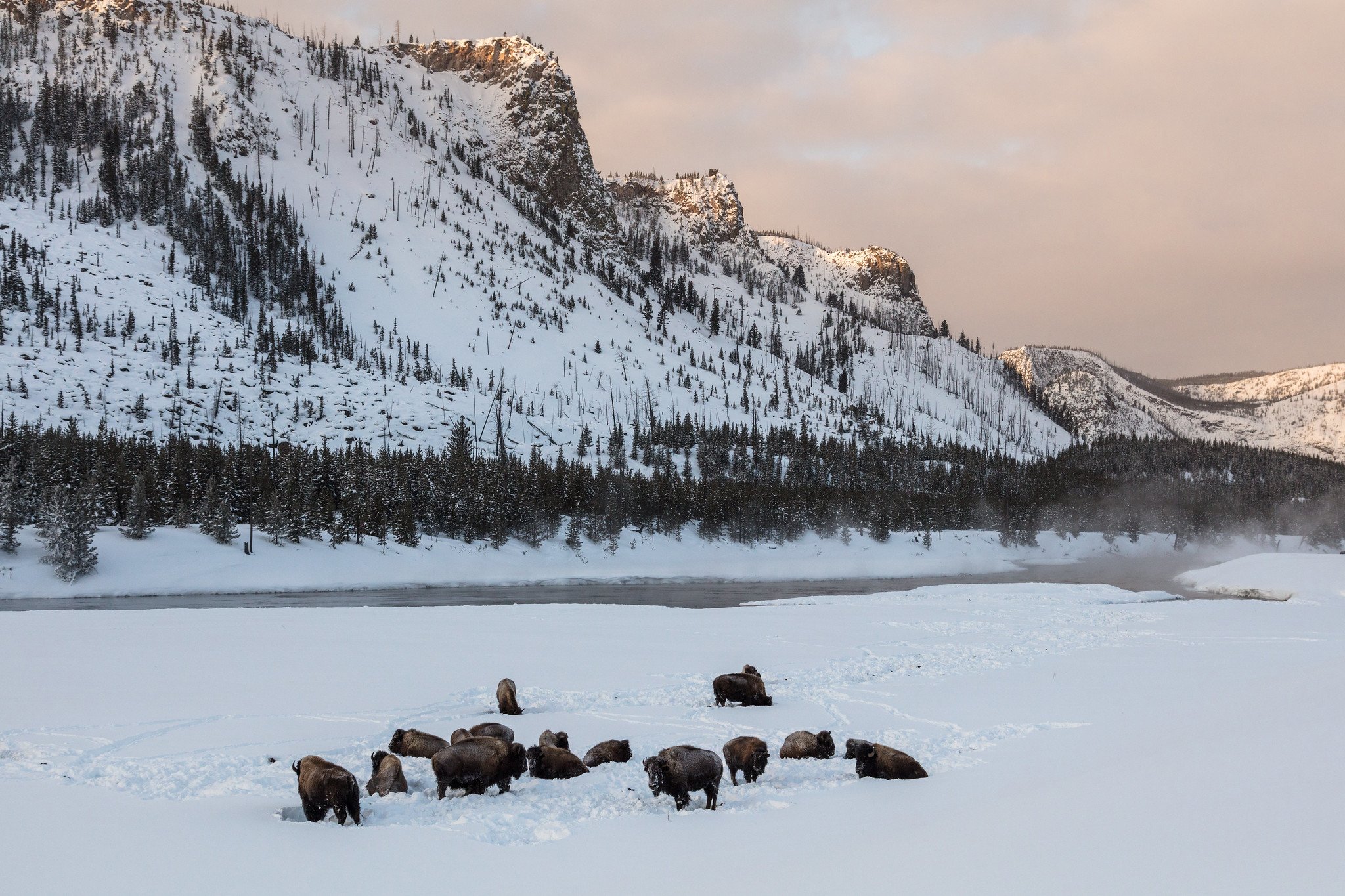Latest Yellowstone Bison Transfer Another Milestone Worth Celebrating
Yellowstone National Park’s Bison Conservation Transfer Program continues to make history. In early February, Yellowstone relocated the largest number of live Yellowstone bison to American Indian Tribes to date. One hundred and sixteen healthy bison were loaded onto secure trucks and moved from Yellowstone National Park nearly 500 miles north to the Fork Peck Indian Reservation where they will complete their final year of testing before being transferred on to Tribes across North America.
Bison bedded down along the Madison River in Yellowstone National Park at sunrise. (Photo NPS / Jacob W. Frank)
To make space for these incoming animals, the Fort Peck Tribes and the Intertribal Buffalo Council transferred 65 disease-free Yellowstone bison to three different tribes the week prior. These hundreds of disease-free, genetically incomparable, and culturally significant buffalo that wandered out of Yellowstone’s borders and were admitted into the transfer program represent the latest conservation success for the animal that was once near the brink of extinction.
The Yellowstone Bison Conservation Transfer Program (BCTP) began in 2018 with the aim to divert wild, disease-free Yellowstone bison from slaughter and restore them to Tribal lands across the country. Yellowstone bison are beyond special – unparalleled in their cultural and ecological significance, and deeply loved by most all Americans. And while the state of Montana continues to force drastic range restrictions and population reduction measures through slaughter, countless Tribes across the country are desperate to welcome home these last wild remnants of the great herds that once roamed the continent.
A yearling bull waits to be released from a trailer onto the Fort Peck Indian Reservation. (Photo Defenders of Wildlife)
Through the BCTP, the Park Service passively captures bison as they leave the park and moves them through a series of testing and holding facilities designed to ensure they are free of the cattle-born disease, brucellosis – first introduced into the ecosystem by cattle in the early 1900s. These first two phases of quarantine can take anywhere from 1.5 years (for bulls) and 2.5 to 3 years (for cows). It is a lengthy, albeit important process to ensure these bison are healthy. The bison are then transferred to the Fort Peck Indian Reservation in northern Montana to finish their final year of assurance testing before being distributed to other Tribes.
Yes, this program is about saving Yellowstone bison. But it’s about so much more. In their new homes, these bison bring more than their numbers; they bring their unparalleled genetics, supporting the long-term health and viability of existing and new Tribal herds. They’ll breathe life back into grassland ecosystems, creating new habitat for a plethora of species including amphibians and birds and promoting plant species diversity, health, and vitality. They will support the culture, economy, nutrition, and food sovereignty of Indigenous people. They will inspire community gatherings and opportunities for youth education. They will bring hope and healing.
What began as a small pilot study with only handfuls of bison entering and graduating from the program has now grown into something of monumental significance. Now, 414 Yellowstone bison have found new homes amongst 26 different Tribes in 12 states.
In 2021, the Greater Yellowstone Coalition raised $250,000 to contribute to expanding Yellowstone’s transfer program. Alongside a $500,000 commitment from the park and $250,000 raised by our partners at Yellowstone Forever, facility upgrades more than doubled the capacity of the program.
More recently, the federal Animal & Plant Health Inspection Service (APHIS) and the state of Montana agreed to shorten the duration of time it takes for bull bison to complete the first two phases of quarantine, from 1.5 years to now just 300 days. We have been advocating for this ever since new published data showed that out of 800 Yellowstone bison tested, no male or female bison seroconvert from testing negative for brucellosis to testing positive, after the 230-day mark, suggesting that testing timelines could be reduced to allow both male and female bison to complete quarantine within one year with negligible risk of brucellosis transmission.
A total of 116 bison were released onto the Fort Peck Indian Reservation the week of February 5, 2024. (Photo Defenders of Wildlife)
While the agencies are not ready to shorten the testing timeline for female (cow) bison yet without more data, the change to the timeline for bulls is significant and a huge win for bison conservation. With this change in timeline along with the quarantine facility expansion that we helped support, we have now quadrupled program capacity since the BCTP began in 2018. This means more bison diverted from slaughter and rehomed to Tribal lands across the county.
This program works. We’re committed to seeing it grow so that one day every quarantine-eligible bison that wanders beyond Yellowstone’s boundary can be saved from slaughter and instead bring new life to Tribal people and their lands; so that Yellowstone bison can lead the way for the continental-wide cultural and ecological restoration of the species.
We are committed to helping Yellowstone National Park move away from managing bison through slaughter while supporting a robust Yellowstone bison population. And while political obstacles remain, new science, modern policies, and strong partnerships have shown that in just two decades tremendous progress can be made if we work together.
— Shana Drimal, Senior Wildlife Conservation Associate




